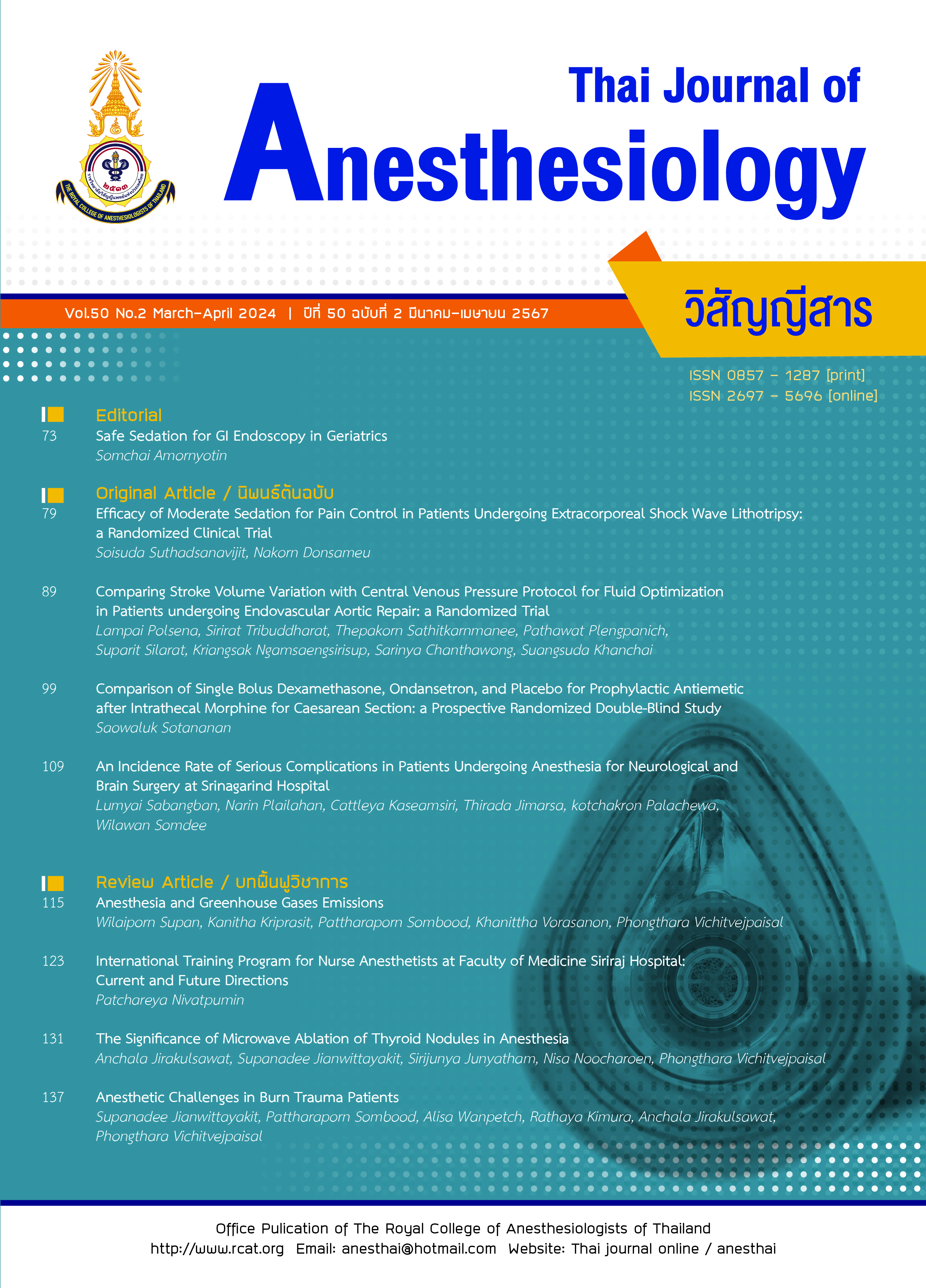Anesthesia and Greenhouse Gases Emissions
Main Article Content
Abstract
Global warming is one of the biggest threats of our time, and it is primarily caused by human activities. While anesthesia is an essential component of modern medicine and is used to provide patients with pain relief and sedation during surgery and other medical procedures; the use of anesthetic agents has been linked to the production of greenhouse gases, which contribute to global warming and climate change. This has led to increased interest in understanding the environmental impact of anesthesia and identifying ways to reduce its carbon footprint. The primary greenhouse gases associated with anesthesia include nitrous oxide and desflurane, both of which are potent contributors to climate change. Nitrous oxide is particularly concerning as it has a long atmospheric lifetime and is nearly 300 times more potent than carbon dioxide in terms of its global warming potential. Desflurane, while less potent than nitrous oxide, has a very high carbon footprint due to its production process and high rate of release into the atmosphere during use. There are a number of strategies that can be employed to reduce the environmental impact of anesthesia. These include using more efficient anesthetic delivery systems, switching to less environmentally harmful agents, and minimizing waste and leaks. Additionally, efforts can be made to raise awareness among healthcare providers and patients about the importance of reducing greenhouse gas emissions from anesthesia.
Article Details

This work is licensed under a Creative Commons Attribution-NonCommercial-NoDerivatives 4.0 International License.
References
Pierce JMT. The environment, the gas bill and the route to sustainable anaesthesia. RCoA Bulletin. 2013;82:39-41.
Wyssusek K, Chan KL, Eames G, Whately Y. Greenhouse gas reduction in anaesthesia practice: a departmental environmental strategy. BMJ Open Qual. 2022;11:e001867.
White SM, Shelton Cl, Gelb AW, et al. Principles of environmentally-sustainable anaesthesia: a global consensus statement from the world federation of societies of anaesthesiologists. Anaesthesia. 2022;77:201-12.
Fang L, Hixson R, Shelton C. Sustainability in anaesthesia and critical care: beyond carbon. BJA Education. 2022;22:456-65.
Van Norman GA, Jackson S. The anesthesiologist and global climate change: an ethical obligation to act. Curr Opin Anaesthesiol. 2020;33:577-83.
McGowan LS, Macksey LF. Reducing the carbon footprint of anesthesia: low-flow anesthesia and other techniques. AANA J. 2022;90:253-62.
Varughese S, Ahmed R. Environmental and occupational considerations of anesthesia: a narrative review and update. Anesth Analg. 2021;133:826-35.
McGain F, Muret J, Lawson C, Sherman JD. Environmental sustainability in anaesthesia and critical care. Br J Anaesth. 2020;125:680-92.
Sherman JD, MacNeill A, Thiel C. Reducing pollution from the health care industry. JAMA. 2019;322:1043-4.
Kleyenstuber T. The environmental impact of anaesthesia. South Afr J Anaesth Analg. 2021;27(Suppl1):S157-61.
Sherman J, McGain F. Environmental sustainability in anesthesia: pollution prevention and patient safety. Adv Anesth. 2016;34:47-61.
McGain F, Hendel SA, Story DA. An audit of potentially recyclable waste from anaesthetic practice. Anaesth Intensive Care. 2009;37:820-3.
Sherman J, Le C, Lamers V, Eckelman M. Life cycle greenhouse gas emissions of anesthetic drugs. Anesth Analg. 2012;114:1086-90.
McGain F, Burnham JP, Lau R, Aye L, Kollef MH, McAlister S. The carbon footprint of treating patients with septic shock in the intensive care unit. Crit Care Resusc. 2018;20:304-12.
Zhong G, Abbas A, Jones J, Kong S, McCulloch T. Environmental and economic impact of using increased fresh gas flow to reduce carbon dioxide absorbent consumption in the absence of inhalational anaesthetics. Br J Anaesth. 2020;125:773-8.
MacNeill AJ, Lillywhite R, Brown CJ. The impact of surgery on global climate: a carbon foot printing study of operating theatres in three health systems. Lancet Planet Health. 2017;1:e381-8.
McGain F, Story D, Lim T, McAlister S. Financial and environmental costs of reusable and single-use anaesthetic equipment. Br J Anaesth. 2017;118:862-9.
Watts N, Adger WN, Agnolucci P, et al. Health and climate change: policy responses to protect public health. Lancet. 2015; 386:1861-914.
Campbell M, Pierce T. Atmospheric science, anaesthesia, and the environment. BJA Education. 2015;15:173-9.
Sherman JD, Berkow L. Scaling up inhaled anesthetic practice improvement: the role of environmental sustainability metrics. Anesth Analg. 2019;128:1060-2.
Ryan SM, Nielsen CJ. Global warming potential of inhaled anesthetics: application to clinical use. Anesth Analg. 2010;111:92-8.
Shelton CL, McBain SC, Mortimer F, White SM. A new role for anaesthetists in environmentally-sustainable healthcare. Anaesthesia. 2019;74:1091-4.
Andersen MPS, Nielsen OJ, Wallington TJ, Karpichev B, Sander SP. Medical intelligence article: assessing the impact on global climate from general anesthetic gases. Anesth Analg. 2012;114:1081-5.
Richter H, Weixler S, Schuster M. The carbon footprint of anaesthesia. How the choice of volatile anaesthetic affects the CO2 emissions of a department of anaesthesiology. Anästh Intensivmed. 2020;61:154-61.
Stevens S. Delivering a ‘Net Zero’ National Health Service. 2020 [cited 2023 May 1]. Available from: https://www.england.nhs.uk/greenernhs/wp-content/uploads/sites/51/2020/10/delivering-a-net-zero-national-health-service.pdf
Newsroom E. London’s University College Hospitals declare ‘climate and health emergency’, set net-zero target. 2023 [cited 2023 May 12]. Available from: https://www.edie.net/londons-university-college-hospitals-declare-climate-and-health-emergency-set-net-zero-target/
McGain F, Story D, Kayak E, Kashima Y, McAlister S. Workplace sustainability: the “cradle to grave” view of what we do. Anesth Analg. 2012;114:1134-9.
McGain F, Jarosz KM, Nguyen MNHH, Bates S, O’Shea CJ. Auditing operating room recycling: a management case report. A A Case Rep. 2015;5:47-50.
Popp W, Rasslan O, Unahalekhaka A, et al. What is the use? An international look at reuse of single-use medical devices. Int J Hyg Environ Health. 2010;213:302-7.
Kwakye G, Pronovost PJ, Makary MA. Commentary: a call to go green in health care by reprocessing medical equipment. Acad Med. 2010;85:398-400.
Costa H. The first carbon neutral health system in the U.S. 2020 [cited 2023 May 12]. Available from: https://about.kaiserpermanente.org/commitments-and-impact/healthy-communities/news/first-carbon-neutral-health-system-in-us
United nation climate change. Global warming potentials (IPCC Second Assessment Report). 2015 [cited 2023 May 9]. Available from: https://unfccc.int/process/transparency-and-reporting/greenhouse-gas-data/greenhouse-gas-data-unfccc/global-warming-potentials


